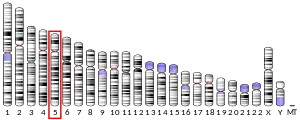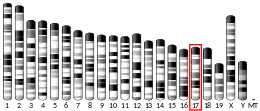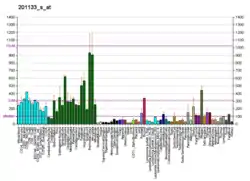| PJA2 | |||||||||||||||||||||||||||||||||||||||||||||||||||
|---|---|---|---|---|---|---|---|---|---|---|---|---|---|---|---|---|---|---|---|---|---|---|---|---|---|---|---|---|---|---|---|---|---|---|---|---|---|---|---|---|---|---|---|---|---|---|---|---|---|---|---|
| Identifiers | |||||||||||||||||||||||||||||||||||||||||||||||||||
| Aliases | PJA2, Neurodap1, RNF131, praja ring finger ubiquitin ligase 2 | ||||||||||||||||||||||||||||||||||||||||||||||||||
| External IDs | MGI: 2159342 HomoloGene: 32233 GeneCards: PJA2 | ||||||||||||||||||||||||||||||||||||||||||||||||||
| |||||||||||||||||||||||||||||||||||||||||||||||||||
| |||||||||||||||||||||||||||||||||||||||||||||||||||
| |||||||||||||||||||||||||||||||||||||||||||||||||||
| |||||||||||||||||||||||||||||||||||||||||||||||||||
| Wikidata | |||||||||||||||||||||||||||||||||||||||||||||||||||
| |||||||||||||||||||||||||||||||||||||||||||||||||||
E3 ubiquitin-protein ligase Praja2 is an enzyme that in humans is encoded by the PJA2 gene.[5]
Interactions
References
- 1 2 3 GRCh38: Ensembl release 89: ENSG00000198961 - Ensembl, May 2017
- 1 2 3 GRCm38: Ensembl release 89: ENSMUSG00000024083 - Ensembl, May 2017
- ↑ "Human PubMed Reference:". National Center for Biotechnology Information, U.S. National Library of Medicine.
- ↑ "Mouse PubMed Reference:". National Center for Biotechnology Information, U.S. National Library of Medicine.
- ↑ "Entrez Gene: PJA2 praja 2, RING-H2 motif containing".
- ↑ Yu P, Chen Y, Tagle DA, Cai T (June 2002). "PJA1, encoding a RING-H2 finger ubiquitin ligase, is a novel human X chromosome gene abundantly expressed in brain". Genomics. 79 (6): 869–74. doi:10.1006/geno.2002.6770. PMID 12036302.
Further reading
- Olsen JV, Blagoev B, Gnad F, Macek B, Kumar C, Mortensen P, Mann M (November 2006). "Global, in vivo, and site-specific phosphorylation dynamics in signaling networks". Cell. 127 (3): 635–48. doi:10.1016/j.cell.2006.09.026. PMID 17081983. S2CID 7827573.
- Suzuki Y, Yamashita R, Shirota M, Sakakibara Y, Chiba J, Mizushima-Sugano J, Nakai K, Sugano S (September 2004). "Sequence comparison of human and mouse genes reveals a homologous block structure in the promoter regions". Genome Research. 14 (9): 1711–8. doi:10.1101/gr.2435604. PMC 515316. PMID 15342556.
- Yu P, Chen Y, Tagle DA, Cai T (June 2002). "PJA1, encoding a RING-H2 finger ubiquitin ligase, is a novel human X chromosome gene abundantly expressed in brain". Genomics. 79 (6): 869–74. doi:10.1006/geno.2002.6770. PMID 12036302.
- Sasaki A, Masuda Y, Iwai K, Ikeda K, Watanabe K (June 2002). "A RING finger protein Praja1 regulates Dlx5-dependent transcription through its ubiquitin ligase activity for the Dlx/Msx-interacting MAGE/Necdin family protein, Dlxin-1". The Journal of Biological Chemistry. 277 (25): 22541–6. doi:10.1074/jbc.M109728200. PMID 11959851.
- Ishikawa K, Nagase T, Nakajima D, Seki N, Ohira M, Miyajima N, Tanaka A, Kotani H, Nomura N, Ohara O (October 1997). "Prediction of the coding sequences of unidentified human genes. VIII. 78 new cDNA clones from brain which code for large proteins in vitro". DNA Research. 4 (5): 307–13. doi:10.1093/dnares/4.5.307. PMID 9455477.
- Mishra L, Tully RE, Monga SP, Yu P, Cai T, Makalowski W, Mezey E, Pavan WJ, Mishra B (November 1997). "Praja1, a novel gene encoding a RING-H2 motif in mouse development". Oncogene. 15 (19): 2361–8. doi:10.1038/sj.onc.1201405. PMID 9393880.
- Bonaldo MF, Lennon G, Soares MB (September 1996). "Normalization and subtraction: two approaches to facilitate gene discovery". Genome Research. 6 (9): 791–806. doi:10.1101/gr.6.9.791. PMID 8889548.
- Nakayama M, Miyake T, Gahara Y, Ohara O, Kitamura T (July 1995). "A novel RING-H2 motif protein downregulated by axotomy: its characteristic localization at the postsynaptic density of axosomatic synapse". The Journal of Neuroscience. 15 (7 Pt 2): 5238–48. doi:10.1523/JNEUROSCI.15-07-05238.1995. PMC 6577874. PMID 7623148.
This article is issued from Wikipedia. The text is licensed under Creative Commons - Attribution - Sharealike. Additional terms may apply for the media files.




